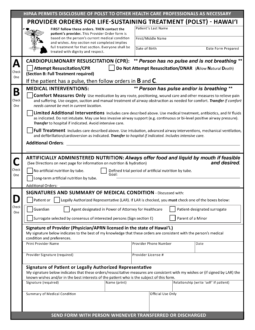Updated July 18, 2023
A Hawaii do not resuscitate (DNR) order is no longer its own form but a clause within Hawaii’s Provider Orders for Life-Sustaining Treatment (POLST) Form. The POLST form allows citizens of the State to have more control over the type of treatments and medical procedures they will receive towards the end of their lives. Among these treatments and procedures is a do not resuscitate section which will prevent medical personnel from attempting to bring a patient back to life should their heart or breathing stop. In the past, Hawaii used a system similar to many states, wherein a patient applies for a DNR form and receives a bracelet so that EMTs, paramedics and the like can identify them. These bracelets are still valid, and health care providers will continue to honor them. It is recommended that patients with terminal illnesses complete a POLST form as it encompasses a wider range of medical interventions.
Laws – § 327K (1-4)
Required to Sign – Patient and physician.
How to Write
Step 1 – Download the POLST form in PDF.
Step 2 – Enter the patient’s full name, date of birth and the current date into the fields located in the top right-hand corner of the form.

Step 3 – Select one (1) of the checkboxes within section ‘A’ – “attempt resuscitation” or “do not attempt resuscitation.”

Step 4 – Under section ‘B’, Medical Interventions, select the desired treatment option – “comfort measures only”, “limited additional interventions”, or “full treatment.” Additional treatments may be specified on the line at the bottom of this section.

Step 5 – The ‘Artificially Administered Nutrition’ section allows the patient to choose the way they will receive food should they be unable to eat normally. Select one (1) of the three (3) available boxes.

Step 6 – Section ‘D’ requires signatures from both the patient (or legal representative) and their physician. If the patient is incapacitated or unable to sign, their legally authorized representative must select the appropriate checkbox as shown below, and enter their name, relationship and signature into the fields at the bottom of the first page of the form. The physician must provide their name, phone number, and license number along with their signature.

Step 7 – In the top section of the second page, enter the patient’s name, date of birth and gender. Next, provide the patient’s emergency contact information including their name, address, phone number. The health care professional preparing the form must enter their name, title, phone number and the date the form was prepared.

Step 8 – Section ‘E’ must be completed if the patient’s authorized representative is a surrogate (indicated by selecting the “surrogate selected by consensus of interested persons” option in section ‘D’). The surrogate must sign, print their name and provide their relationship to the patient in this section.



